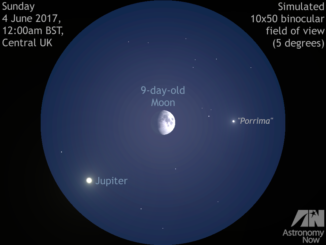
What’s in a name? When it comes to moons, quite a lot.
That’s what many participants probably realised earlier this year when we asked them to tweet us suggestions to help name five of the recently discovered moons of Jupiter.
“There are many rules when it comes to how we name moons,” said Carnegie’s Scott Sheppard, who last July announced the discovery of 12 new moons orbiting Jupiter, five of which were the subjects of this contest. “Most notably, Jovian naming conventions require its many moons to be named after characters from Greek and Roman mythology who were either descendants or consorts of Zeus, or Jupiter.”
But there are plenty of other strictures as well, including maximum character lengths and the final letter of each name, depending on the direction of a moon’s orbit.
From February to April, we solicited name suggestions and the submissions ranged from the scholarly to the silly, including some inevitable Moony McMoonFaces and a surprisingly large number of people who felt strongly about naming the moons after a beloved pet. We combed through them all — even the ones that blatantly disregarded the rules — and passed the best ones on to the International Astronomical Union.
Today, the IAU is publishing the winners:
S/2017 J4 is now Pandia
She is the daughter of Zeus and the Moon goddess Selene. Pandia is the goddess of the full moon and the sister of Ersa. The name Pandia was one of the more popular names submitted for a Jupiter moon. Our favourite submission of the contest was representing the astronomy club of Lanlivet School in Cornwall England. Emma Hugo (@emmabray182) tweeted a picture of the astro club with a Pandia sign and the school’s Panda mascot, which is in honour of the village’s former role as bamboo supplier to the London zoo.
S/2018 J1 is now Ersa
She is the sister of Pandia and, as such, also the daughter of Zeus and the Moon goddess Selene. Ersa is the goddess of dew. There were more than 20 tweets suggesting the name Ersa. Being the daughter of a Moon goddess seemed very appropriate for a Jovian moon. The first submission was from space news aggregator Aaron Quah (@8603103) and the submissions that most caught our eye about Ersa were submitted by the 12th grade students of Saint Sauveur High School in Redon, France (@StSauMoons), on behalf of the fifth grade at Hillside Traditional Academy in Mission, British Colombia (@mrgrouchypants), and on behalf of a 4-year-old lunar expert Walter who sang us a moon song (@Thoreson).
S/2003 J5 is now Eirene
She is the goddess of peace and the daughter of Zeus and Themis. About 16 tweets suggested naming a Jupiter moon Eirene. The first submission was from Quadrupoltensor (@Quadrupoltensor), and the entry for Eirene that caught our eye (@PJRYYC) was submitted on behalf of a 10-year-old who loves Greek and Roman mythology.
S/2003 J15 is now Philophrosyne
She is the spirit of welcome and kindness and is the granddaughter of Zeus and sister of Eupheme. Winning submissions were from an 11th grade history class with a proclaimed interest in Greek and Roman mythology, CHW3M Myth Experts (@Chw3mmyths); Victoria (@CharmedScribe); and Lunartic (@iamalunartic), an account dedicated to moons, which posted several videos about the contest, including one that evaluated this suggestion.
S/2003 J3 is now Eupheme
She is the spirit of praise and good omen, the granddaughter of Zeus, and the sister of Philophrosyne. Winning submission was from the same video by Lunartic (@iamalunartic).
“I was blown away by the enthusiastic response for this contest,” said Sheppard. “I hope the thought of these moons let everyone ponder the wonder and amazement that is our universe.”



